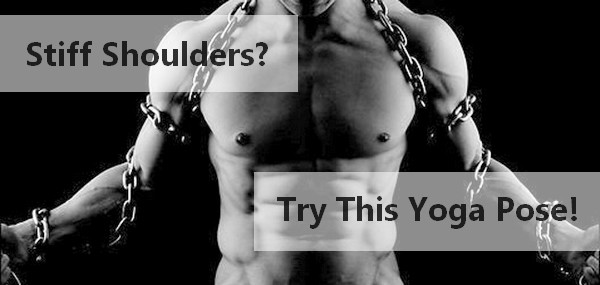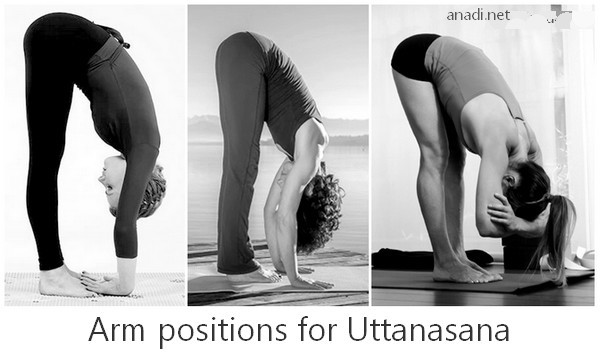What are the benefits?
The pose is called Bandha Hasta Uttanasana. If you regularly practice this pose, it improves your posture, removes any chronic tension in the upper back, shoulders and the base of the neck. It also helps to relieve pain.
If you combine the pose with slow and deep breathing, your lungs’ size increases.
The benefits of the pose cover your heart, blood vessels and the brain. But you have to do it daily if you want to enjoy all these.
A Word of Caution
The pose does not have any serious contraindications with the exception of prolapsed disc and hernia – you should avoid deep bends if you have these conditions.
Also you shouldn’t simultaneously overfill your lungs with air and strain the core muscles of your body as it creates an unhealthy pressure in your lungs.
How to do the pose to get rid of stiffness
 Stand up straight, keep your feet at hip width or together. Your arms are relaxed along the body. Close your eyes and make 3-4 slow and deep breaths (it will take around 30-60 seconds).
Stand up straight, keep your feet at hip width or together. Your arms are relaxed along the body. Close your eyes and make 3-4 slow and deep breaths (it will take around 30-60 seconds).
Cross your hands at the wrists while keeping them at the pelvis level (it doesn’t matter which palm is on top). Keep the palms open, don’t clench them into fists. This is the starting position.
 Open your eyes, look forward, keep the neck up and straight, but not strained.
Open your eyes, look forward, keep the neck up and straight, but not strained.- Lower the eyes towards the crossed hands and with slow inhalation raise your arms up to the head level, then above your head until the shoulders won’t allow you to go any further. Follow the movement of the arms with your eyes.
- When you reach the top position with the arms, your head will slightly lean backward, and your gaze should be over the palms. Do not strain yourself too much; there could be just a little tension, that’s all. All this is done along with inhalation.
- Now, although your lungs seem to be full already, try to slowly inhale a little bit more of air into them along with the expansion of your chest, and stretching the arms to the sides. At this point you will discover more room for the air in your lungs, as your arms go to the sides.
- Hold your breath for a second without tension. Actually you need to relax as much as you can. If the holding of breath at this point is uncomfortable for you, just skip it.
- With slow exhalation move the arms back to the over-the-head position, crossing them as before.
- Continue exhalation while lowering your arms to the starting position. The full exhalation should coincide with the full lowering of the arms. This is the full cycle.
You should aim at doing the full cycle for 1 minute. If you cannot do it that slow don’t worry – it will come with the regular practice.
Do not hold your breath after finishing the first cycle – proceed immediately to the second one. You need to do 5-10 cycles.
But there is the second part too!
Once you complete 5 or 10 cycles, return to the starting position and relax breathing normally.
The forward bend
- Inhale slowly raising your gaze to the ceiling as you inhaling.
- Now start exhaling slowly, lower your head and start bending forward at the hips, keeping your back as straight as possible. Release the arms towards the floor (or you can hold your elbows if you like – see the image below).
- Your exhalation should complete once your reach the lowest position comfortable for you. Stay in it breathing normally and trying to relax your spine and shoulders. Hold this position for 30-60 seconds.
- Now raise your head with inhalation as much as you can but without an excessive tension. Lower your head with exhalation.
- On inhale return to the starting position and complete the full cycle as described above (raising your arms over the head, etc.).
- Return to the starting position and relax. That’s all!
 You can do the second part once or up to 3 times per session. Be careful with it if you have lower back problems and do not attempt to do it in case of prolapsed disc or hernia (perform only the first part).
You can do the second part once or up to 3 times per session. Be careful with it if you have lower back problems and do not attempt to do it in case of prolapsed disc or hernia (perform only the first part).
When to expect the result?
It may come immediately after the completion of the exercise, or it may take few days to experience the stiffness going away.
Few more notes
Some people may experience some dizziness in the beginning – just be careful, do not force your practice and it will pass. Drop breath retention for a while – it may help.
If this exercise is done for longer than 5 minutes along with slow breathing, it will calm your mind and nerves. But keep an eye on your breath – it should not speed up; keep it slow.
As an additional benefit, the practice of this exercise will contribute to mastering such techniques as Nasikagra-drishti and Shambhavi Mudra.
